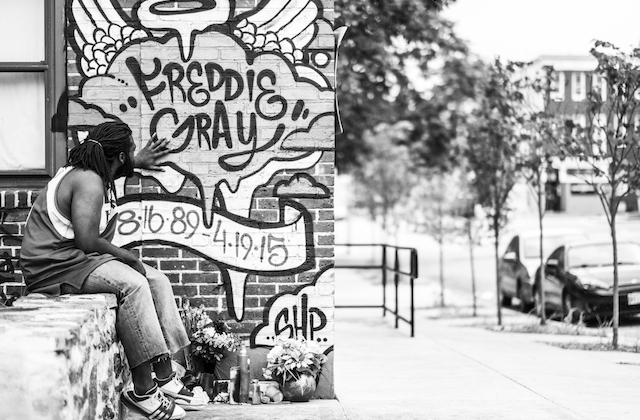When Devin Allen decided to shoot scenes from his hometown of Baltimore, Maryland, he didn’t suspect that they would turn into a book. "The book came together beautifully, but it was never the plan," he tells Colorlines. "It just so happens that I had a big enough catalog of stuff from just hanging outside every day, shooting and being around my peers." That book, "A Beautiful Ghetto," debuts via Haymarket Books today (September 12).
Some of Allen’s catalog became famous in 2015, when anger about the Baltimore police killing of Freddie Gray turned into unrest that pitted its Black residents against local police in riot gear and their federal allies. One of Allen’s photos landed on Time‘s May 2015 cover, making him only the third amateur photographer to do so in the magazine’s nearly hundred-year history. Publications including New York Magazine and The Washington Post also ran his work, giving readers around the world a glimpse into how Black Baltimoreans resisted racist policing in their neighborhoods. "A Beautiful Ghetto" features many of those photos in tandem with scenes of everyday life. Here are five images from "A Beautiful Ghetto" and the stories behind them.
{{image:2}}
"This image shows Kevin Moore, almost a month after the uprising, when everything was settling down. That was my first time ever doing [official] photojournalism, and Time asked me to find him and write about his story. He was arrested for recording Freddie Gray’s arrest and releasing that video, and he helped set up Copwatch. He’s probably one of the most iconic people that will always be remembered as part of the uprising, and he lived in [Gray’s residence] Gilmor Homes and knew Freddie Gray."
{{image:3}}
"That whole day was powerful. That was from the week after the uprising. We marched a couple of blocks to City Hall. It was raining, but the whole community was out there. I was actually standing on a podium where people were speaking, just shooting. And I just saw this kid who, when the speakers were speaking, was so engulfed. He had this look on his face like he could feel every single word coming out of the speaker’s mouth. I was shooting with little 35mm lens, and usually I have to get closer to get the shots that I want. And I try not be seen because I hate to [interrupt these intimate] moments. But he was so in tune with the speakers, he didn’t even notice that I walked up, crouched down and snapped the photo. It was so powerful, because we have to teach our kids so young on how to interact with the police. At his age, I learned, ‘Don’t talk back to the police, make sure they can see your hands, and avoid them,’—that’s the first step to your defense, is to not come in contact with them."
{{image:4}}
"That’s the Time cover. People say that it must be my favorite photo, but it’s not. I didn’t think anything of it. Ninety percent of this book was shot in black and white, with no edits, post-processing, nothing. A lot of people don’t know the reason why my photos were going viral so fast—that I was mass-producing in real time. I shot that photo while the police were charging, I sent it to my phone, tweeted it, posted it on Instagram and then kept shooting. I just thought it was a dope picture. Next thing I knew it went viral."
{{image:5}}
"That photo was taken on Hollins Street. In Baltimore, there’s a store called City of Gods. It’s a clothing store but also a spot where you can always feel safe. That same street is where I started as photographer; I took some of my first photographs on that block. I used to have a poetry night there with my friends back in 2011 and 2012, and that’s what actually got me interested in photography. In this picture are three of my homeboys. We were just chilling outside. On a nice day in Baltimore, everybody brings their toys out—dirt bikes, four-wheelers, and my friend came through in a three-wheeled car thing. The one in a jean jacket, standing, is one of my friends who grew up in Gilmor Homes with Freddie Gray. That’s how small Baltimore is. I love that image because it shows one of those good, tranquil moments that we have in Baltimore that people don’t talk about. Those moments keep us cushioned. I wanted to show in the book that although Baltimore’s a very tough place, we have a lot of kindred spirits and love here."
{{image:6}}
"That’s another one of my favorite photos. My friend Rico, who was killed in December, was friends with Freddie Gray. He was talking on a bullhorn [during a demonstration], and this police officer’s eyes were watering. He had just snapped his helmet on, and he was listening to Rico expressing the pain of losing Freddie in the way we did. He was asking the cops, ‘Why do you hate us?’ A lot of people saw this image and said, ‘Oh, that cop has allergies, he’s not really tearing up.’ But I was there and he was crying. When Rico began to talk, the words were so powerful. When you’re a Black cop, you got to understand what that does to your psyche. You can see that in his eyes. You’re on the job with the blue gang, but at the end of the day, you have to live with how it conflicts with your soul when you’re listening to a brother—with the same melanin that you have—asking why you hate them. The same things can happen to you when you take off that uniform."
Visit HaymarketBooks.com to purchase "A Beautiful Ghetto." New York residents can see Allen’s photos during a September 15 exhibit at The Gordon Park Foundation, where Allen is a 2017 fellow.
